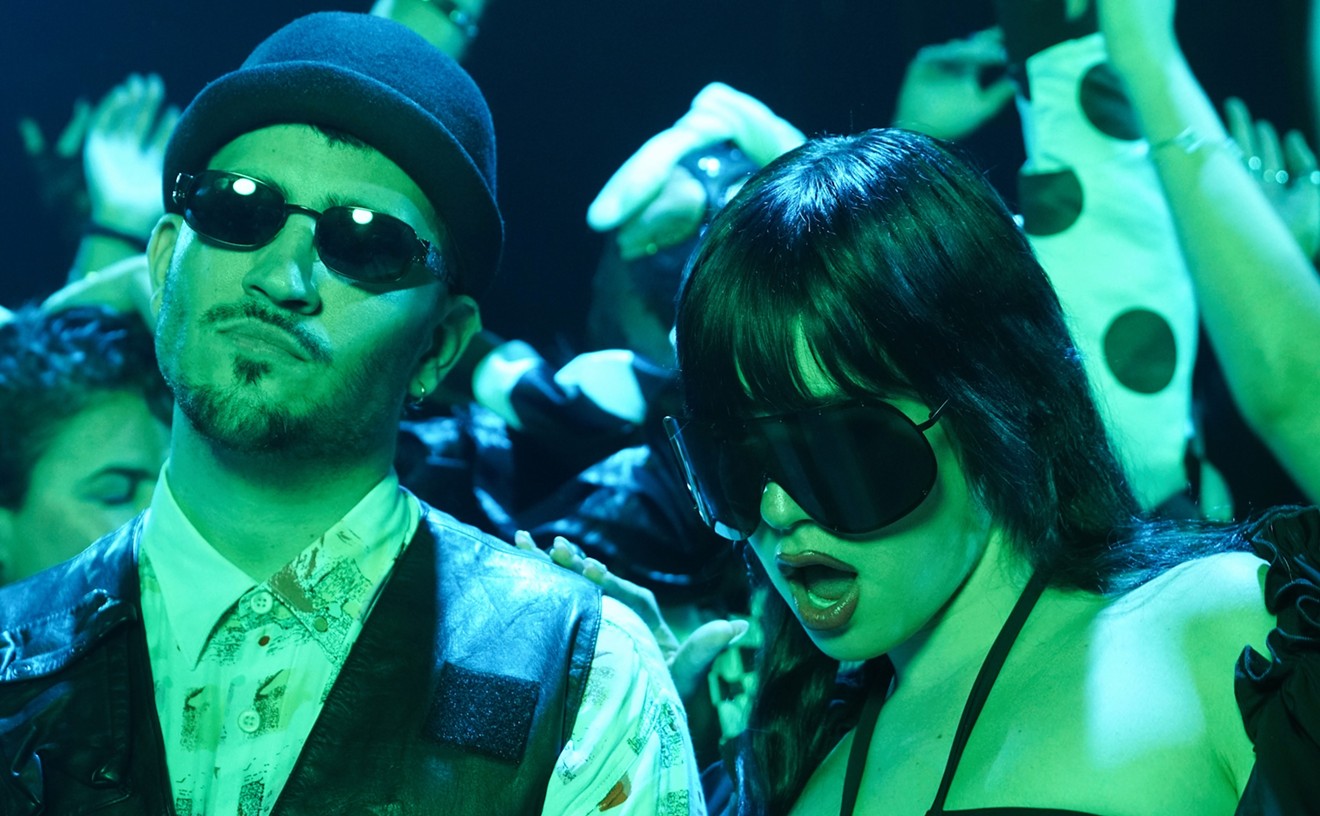Imagine, but don't expect to actually experience, all that at this Saturday's Recombinant Music Lounge at the Port of Miami's Terminal 12. Because although something like the "tactile, 3-D audio environment" described in the event's press release has been experimental musician Naut Humon's dream for a long time, he's admittedly not quite there yet. The Recombinant Music Lounge was designed, he points out, as "a sneak preview."
The show's eclectic lineup features avant-garde New York City electronic artists We, DJ Spooky, and Badawi, plus London club DJ Mixmaster Morris, as well as a handful of hip-hop turntable wizards, including the Bronx's X-ecutioners, L.A.'s Beat Junkies, and San Francisco's Invisibl Skratch Piklz.
Also on exhibit will be installations by Austrian artists Hive Music and Granular Synthesis. The former will import sounds and images from remote Miami locations to Terminal 12 through a specially designed recording network. The latter will present an audiovisual production called MODELL5, which Humon describes as a step toward "a new language where the visual is functional, not decorative."
Simultaneously, one floor below the Recombinant Music Lounge, expect a more traditional evening of performance featuring the bands Electric Skychurch, Rainbow Bridge, and Vortex. The Recombinant Music Lounge is the third event of its kind, at least by that name, and the first on the East Coast (the other two were held in L.A. and San Francisco in the fall of 1996). Central to the event is a six-channel audio delivery system called Sound Traffic Control. According to Lloop, who performed at the 1996 Recombinant festivals as a member of We, it employs technology developed for cinematic surround sound, as well as signal-delay techniques originally designed to perfect the amplification of music in venues such as football stadiums.
The word recombinant comes from the field of genetics. It refers to the process through which offspring come to possess characteristics not present in either parent. Sound Traffic Control is the machine that will link all the Recombinant performers' music together, but how did artists from so many disparate scenes end up on the same bill in the first place? To understand that, one must grasp the aspirations of Humon -- the man behind Sound Traffic Control. And to understand, in turn, how Humon sees the future of music performance, you have to consider his past. After a stint as a child professional stage actor in his native Seattle, the teenage Humon became involved in San Francisco's experimental theater scene in the early Seventies.
"We decided that the best way to deal with creative modes was to start from scratch," he says. "Throw away the script and the preconceptions and start from a blank slate." One event that Humon helped to stage, Dancing on Dead Rock, took place in complete darkness. He and other actors in the company (which later took the name Cripple Destiny) played the roles of mobile pieces of furniture. They also used rented rain machines (the kind used for film shoots), plus devices to spread different aromas. Thus they created a "climate" for the lightless performance room, with live and (then very experimental) tape-splice music filling the air.
"People would start off afraid and then get accustomed to it," Humon recalls. "They'd be transformed and would eventually start initiating activity and dictating what was going on, reacting to how the weather conditions in the room were changing." For the finale, he adds, "as people emerged, actors portraying news reporters would take flash pictures and interrogate the audience."
If Dancing on Dead Rock served as a metaphor for what Humon terms "a culture getting used to the dark," his subsequent work with the group Cellar M provided a new slew of challenges. Cellar M evolved out of Cripple Destiny's soundtrack work. As most Californians grooved to the harmonious sounds of Crosby, Stills and Nash and the Eagles, Humon and his cohorts were breaking into abandoned San Francisco warehouses, "like one with a twelve-second echo," he remembers, "then modifying vacuum cleaners with surgical gloves to make this siren sound."
Cellar M's performances fell somewhere between concerts and theater, sometimes merging music with recorded narratives or video techniques developed by high-tech artist Nam June Paik. Humon became increasingly interested in the use of hypnotic, synthesized rhythms. By the Eighties Humon and crew had a warehouse of their own: the Bloody Angle Compound, a 1500-square-foot space located in a nonresidential part of San Francisco. It's there that performance collective Cellar M evolved into the recording group Rhythm and Noise, which toured the United States in the mid-Eighties.
On the road they sought to redefine the orchestral process. Perhaps because of the musicians' theatrical background, they saw their collaboration as analogous to the work of a film crew, as opposed to that of a band. Rhythm and Noise thought of itself as a network of cooperating workers -- each with a completely different job, all of them contributing to a technologically integrated whole. Instead of instruments on one side of a room and an audience on the other, they imagined listeners at a hub surrounded by sounds in fluid motion.
"I didn't want to characterize myself as a musician," Humon explains now. "I sort of viewed myself as a sound traffic controller, one who directs sound through space, editing and conducting in a way that's not like playing an instrument so much as mixing and layering sounds."
A major factor in bringing the Sound Traffic Control idea to fruition came from the Panasonic corporation, which was interested in developing new uses for its technologies. According to Humon, Panasonic's Japanese investors gleaned his name from a list of vanguard DJs (where it technically didn't belong; Humon, though certainly vanguard, was not a DJ at all) because they mistakenly interpreted it as "Not Human."
In 1991 Humon seized the opportunity and acquainted his potential patrons with his idea for "a sonic airport, where the musical cargo lands, taxis, and takes off, and the audience are like passengers who roam the imaginary runways between the musical trajectories that are flying around the room." Their response, Humon remembers, was "We build you control tower! You have airport!"
Humon and collaborator Maryanne Amacher arrived in Japan to find a full-size control tower sculpted from scrap metal and garnished with 800 speakers and dozens of TV monitors. Panasonic "facilitated the first real-time version of this crazy idea," he notes. "People got a glimpse -- and we got a glimpse -- of what we wanted to do later."
Upon returning to the Bloody Angle, Humon was determined to acquire the funds he'd need to see his dreams realized: "We needed money for research and development to create a team of people to create a giant musical instrument -- a new orchestral organism."
With his wife Mitzi Johnson -- an accomplished musician (electric lute) in her own right who is currently co-producing the next Diamanda Galas album -- Humon started a record label in 1993. The idea was to flush out other artists who, like Rhythm and Noise in the early Eighties, made experimental music in seclusion. Johnson named the label Asphodel after the mythological flower that grows on the banks of the river Styx. Citing "the flower that grows where no other flowers grow," Humon characterizes the label's interests as traversing the boundary between "the aggressive and the sublime in music."
The first Asphodel project was a collaboration with RE/Search Publications on the Incredibly Strange Music, Vol. 2 compilation, released in March of 1995. (It features music by the likes of Ken Nordine, Les Baxter, and something called the Nirvana Sitar & String Group. The series as a whole helped spawn the recent exotica/lounge-music revival.) More instrumental work followed, starting an uninterrupted string of nonvocal Asphodel releases that will finally end later this year when the label -- in conjunction with the Mute imprint -- releases the new Galas album.
In the pop music world Asphodel's most visible signees are a collective of young, educated New York DJs who work under the genre tag "illbient." (The word illbient comes from merging the adjective ambient with the hip-hop term ill.) All of the illbient artists combine conceptual sound experiments -- of the sort that Humon and his colleagues pioneered -- with urban music. Illbient Asphodel artists and Recombinant Music Lounge performers We, DJ Spooky, and Badawi all use ghostly drones and slamming, syncopated beats.
But Humon didn't stop exploring youth culture when he discovered musicians whose interests overlapped with his own. He allowed his realm of inquiry to expand into theirs and soon found new borders to cross. The illbient DJs' approach is primarily intellectual, but by tracing their less conceptual sources of inspiration to the ghettos of Nineties New York City -- perhaps as far from the Sixties Californian experimental theater scene as one can get -- Humon discovered another mature, reclusive, highly technological culture of musical hybridization. In short, he found out about experimental hip-hop and brought it to Asphodel.
It's not crass, shallow rap music that Humon sought to nurture, but rather the refined descendants of the multimedia street art from which it was born. The move demonstrated the extent of Humon and Johnson's commitment to musical crossbreeding. Asphodel's first hip-hop contractees were the X-Men, a renowned group of DJs who later changed their name to the X-ecutioners. They had developed old-school turntable scratching and live mixing tricks to unprecedented levels of virtuosity, making a strong case for the viability of the turntable as a musical instrument in its own right. On their recent debut album X-Pressions, the X-ecutioners applied their real-time, analog sensibility to the digital recording studio.
Humon and Johnson's label also snatched up the fastest scratchers on the West Coast, the Filipino-American crew Invisibl Skratch Piklz (their first album is expected to come out on Asphodel later this year). From the Bay Area, the Piklz (pronounced "pickles") invented a kind of ensemble turntable performance that mimics the orchestration of a rock band. At the Recombinant fest, members of the Piklz and the X-ecutioners will "battle" (i.e., perform in a competitive setting) against DJs from the Los Angeles group Beat Junkies, local "beat juggler" DJ Craze, and fifteen-year-old turntable champion A-Track.
The turntablists, the illbients, the Austrian free-theater artists, and the Sound Traffic Control system make for lot of material to integrate into a single evening, but Humon is intent on presenting a focused environment. Calling the lounge an "intermediate step" toward a production in which all the constituent elements are combined, he says the show will provide a roster of examples of an emerging art form. He's also quick to laud the efforts of local arts group Miami Light Project, which is sponsoring the event. "It costs way more to produce these things than a music audience can pay for," he points out. "They generously came up with the funds to bring in the artists."
The Recombinant Music Lounge takes place from 9:00 p.m. Saturday, March 7, to 10:00 a.m. Sunday, March 8, at the Port of Miami's Terminal 12; 531-3747. Tickets cost $20 ($10 for students with










